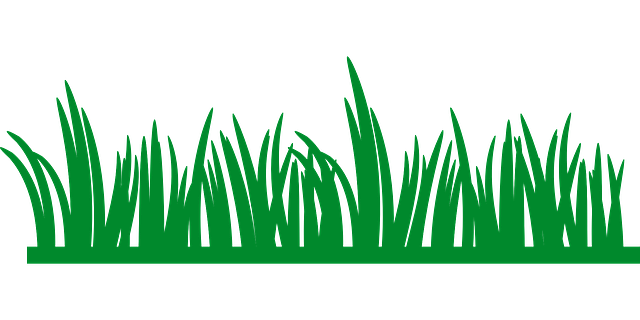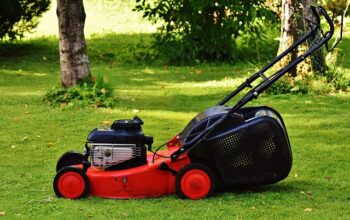Implementing strategic mulching and precise edging are key practices for optimal lawn care and landscaping. Mulch aids in conserving soil moisture, moderating temperature, and preventing weeds, thereby promoting grass health. Selecting the right type and depth of mulch tailored to your local conditions is crucial to reap its benefits without causing harm from excessive or insufficient layers. Organic mulches like bark or wood chips not only serve their immediate purpose but also gradually enrich the soil with nutrients as they decompose. Edging, often overlooked yet vital, defines clear boundaries between your lawn and other areas, which helps maintain aesthetic appeal, prevents grass intrusion, and reduces weed pressure. Regularly maintaining these defined edges enhances curb appeal and makes lawn care more efficient by simplifying maintenance tasks. By integrating these practices into a comprehensive lawn care and landscaping routine, homeowners can achieve healthier turf, minimize resource competition among plants, and enjoy a visually appealing outdoor space that is both robust and enjoyable throughout the year. These practices are not only beneficial for lawn health but also for creating a balanced and well-manicured landscape that requires less maintenance and is more resistant to pests and diseases.
title: “Optimizing Your Lawn’s Health: The Role of Mulching and Edging in Effective Lawn Care and Landscaping”
A well-maintained lawn is the hallmark of a beautifully landscaped garden, and mastering the art of mulching and edging are key components to achieving this. These practices not only enhance the visual appeal but also promote a thriving turf ecosystem. In this article, we delve into the essentials of ‘Mastering Mulching Techniques for a Thriving Lawn’ and ‘The Art of Edging: Defining and Enhancing Your Lawn’s Borders.’ Furthermore, we explore how integrating these methods into your lawn care and landscaping routines can lead to a healthier, more vibrant lawn. Discover the transformative impact of mulching and edging on your outdoor spaces for a landscape that stands out.
- Mastering Mulching Techniques for a Thriving Lawn
- The Art of Edging: Defining and Enhancing Your Lawn's Borders
- Integrating Mulching and Edging into Effective Lawn Care and Landscaping Routines
Mastering Mulching Techniques for a Thriving Lawn

Engaging in masterful mulching techniques is a cornerstone of effective lawn care and landscaping. Mulch serves as a protective barrier that retains soil moisture, moderates soil temperature, and suppresses weed growth, thereby fostering an optimal environment for your grass to thrive. When applying mulch, it’s crucial to consider the type and depth appropriate for your specific turf and region. A thick layer can suffocate the lawn, while an insufficient layer may fail to provide the intended benefits. Utilize organic materials like shredded bark or composted wood chips, as they decompose over time, further enriching the soil with nutrients that benefit your lawn. Regularly assess your lawn’s condition and moisture levels to adjust your mulching strategy accordingly. This attentive approach to mulching not only enhances grass health but also contributes to a visually appealing and well-maintained landscape.
Edging, often overlooked in lawn care and landscaping, demarcates the perimeter of your lawn, creating a clean and distinct separation between your turf and garden beds or hardscapes. By maintaining crisp edges, you not only improve the visual appeal but also prevent grass from encroaching onto walkways or driveways, and from growing into flower beds, which can lead to competitive weed pressure. The right edging tool, whether manual or powered, combined with consistent upkeep, ensures a sharp boundary that frames your lawn beautifully. This attention to detail in mulching and edging not only elevates the aesthetic of your property but also supports a healthier and more vibrant lawn ecosystem.
The Art of Edging: Defining and Enhancing Your Lawn's Borders

Lawn care and landscaping professionals often emphasize the importance of precise edging to define and enhance lawn borders. Edging serves a dual purpose: it provides a clean demarcation between your verdant lawn and garden paths or flowerbeds, and it helps prevent grass from encroaching onto walkways or driveways. This physical separation not only maintains the aesthetic appeal of your landscape design but also allows each plant community to thrive without competition for resources. By using edging tools such as manual spades, half-moon edgers, or mechanical edge trimmers, homeowners can create sharp, defined lines that accentuate the contours of their lawns. This meticulous process not only contributes to the visual harmony of the yard but also facilitates easier maintenance, making lawn care and landscaping tasks more manageable. Additionally, maintaining clear borders can help control the spread of grass and weeds, reducing the need for frequent mowing and eliminating unsightly overgrowth that can detract from your outdoor living spaces. Incorporating edging into your regular lawn maintenance routine is a key aspect of effective landscaping that can elevate the curb appeal of your property and provide a satisfying boundary between different landscape areas.
Integrating Mulching and Edging into Effective Lawn Care and Landscaping Routines

Incorporating mulching and edging into your lawn care and landscaping routines can significantly enhance the aesthetic appeal and health of your lawn. Mulching, the practice of spreading a protective covering over the soil, serves multiple purposes. It conserves moisture by reducing evaporation, suppresses weed growth by blocking sunlight, and improves soil quality as it breaks down over time. When integrating mulching into your lawn care regime, select organic materials like wood chips or straw that are free of seeds and invasive species. These materials not only enrich the soil with nutrients but also maintain a consistent moisture level, reducing the need for frequent irrigation.
Edging, on the other hand, defines clear boundaries between your lawn and garden beds, walkways, or driveways. It delineates different areas within your landscaping, which contributes to a neater, more polished appearance. Edging can be accomplished with various tools like shovels, manual edgers, or gas-powered machines. Regular edging prevents grass from encroaching onto paths or into flower beds, which can simplify maintenance and reduce the likelihood of lawn diseases spreading to other parts of your garden. When combining mulching and edging with overall lawn care and landscaping practices, consider the types of plants in your landscape, the soil composition, and local climate conditions. This holistic approach ensures that each aspect complements the others, leading to a more robust, healthy, and visually appealing lawn and garden environment. Regular maintenance, including both mulching and edging, as part of your lawn care and landscaping schedule, will yield a well-maintained outdoor space that can be enjoyed throughout the seasons.
Effective lawn care and landscaping hinge on precision techniques such as mulching and edging. Mastering these practices not only beautifies your lawn but also fosters its health and vitality. By applying the right mulch around plants and maintaining crisp, clean edges along borders, homeowners can achieve a well-manicured landscape that withstands the elements and thrives throughout the seasons. Integrating these tasks into your routine will yield a lawn that stands as a testament to your commitment to excellence in lawn care and landscaping.




